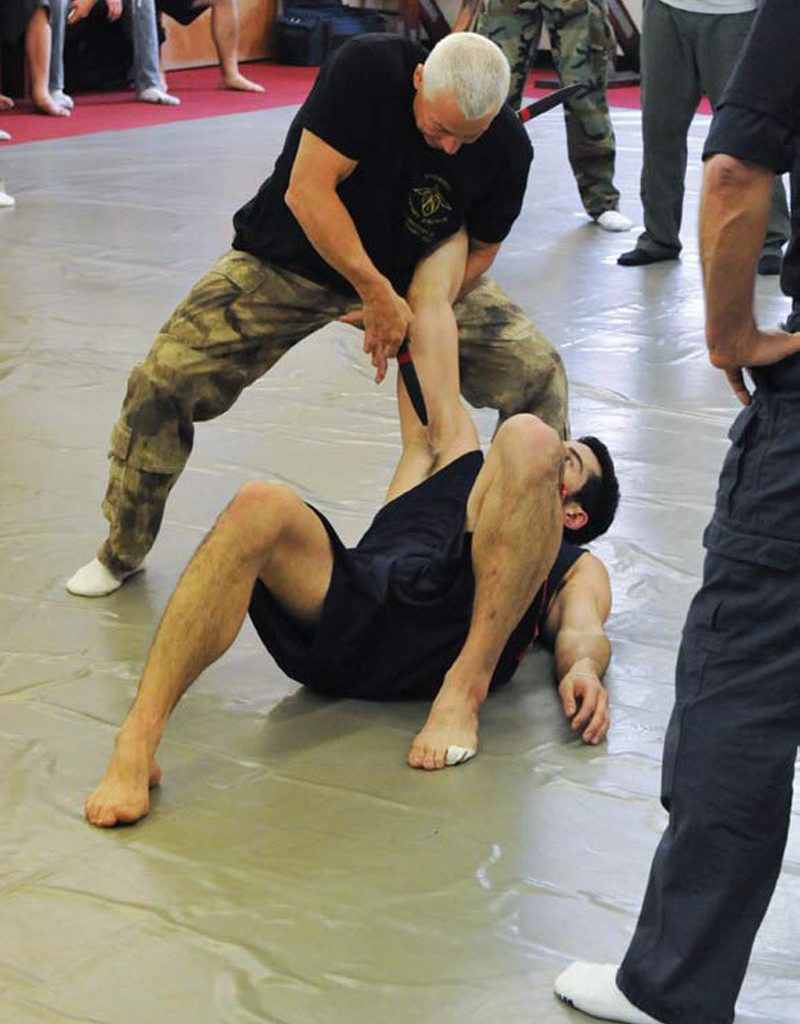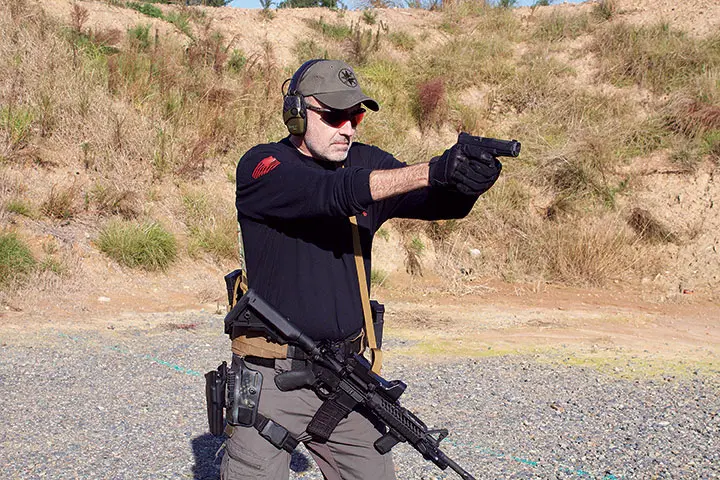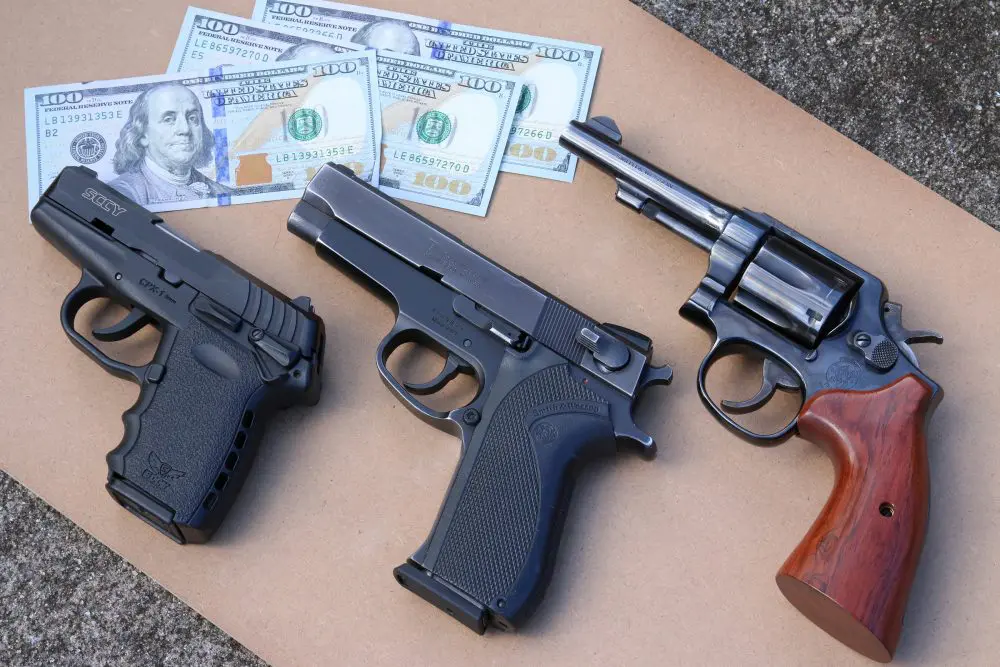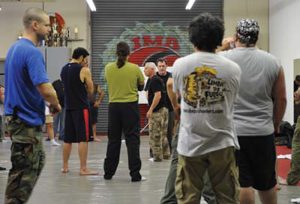
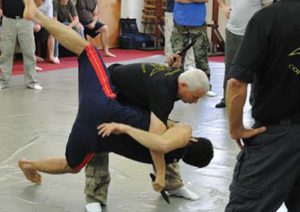
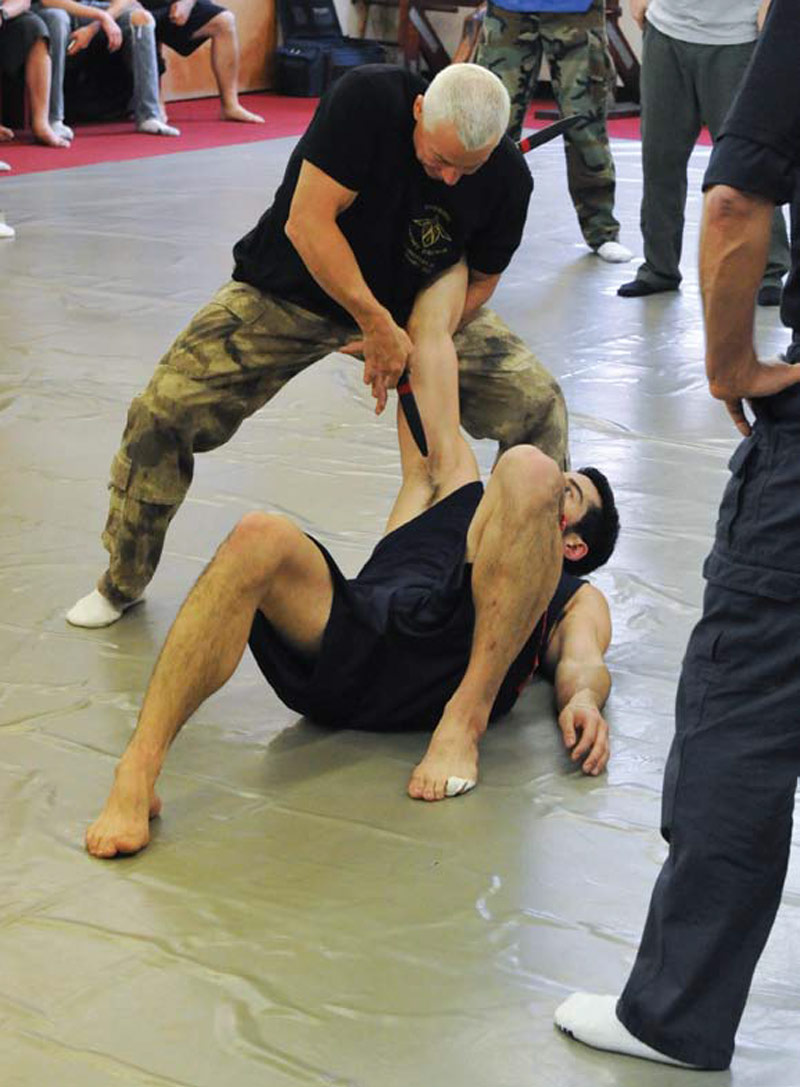
His knives, favored by elite military units and SWAT officers around the world, are often credited with jump-starting the tactical knife trend and even served as the catalyst for the creation of one of the Internet’s largest online discussion forums about custom tactical knives (www.usualsuspect.net).
What many people may not realize is that Emerson is an accomplished fighter and martial artist with an accumulated 35 years of experience in a variety of styles and philosophies of combat. Drawing upon this base of knowledge and experience, he has developed a method of fighting that has been taught to hundreds of law enforcement agencies, members of the U.S. military, and civilians. The Extreme Close Quarters Combat Course I attended was Emerson’s first West Coast class offered since 2006. The class ran for two full days.
Day One was spent at I&I Sports in Carson, California, and Day Two took place at Richard Bustillo’s prestigious IMB Academy in nearby Torrance. Students included police officers, active- duty military, bodyguards, MMA instructors, private military contractors and devotees of various fighting disciplines. One student was a businessman whose work takes him to particularly dangerous locales in the Third World.


Table of Contents
TRAINING DAY ONE
After all the students had assembled and signed the standard waivers, forfeiting any rights to sue in case of injury, introductions were made. Emerson explained the course rules and gave an outline of what to expect over the next two days. When he’d finished, he turned the class over to the first of three guest speakers: Los Angeles Superior Court Judge Larry Paul Fidler.
Judge Fidler spoke for 40 minutes on the use of deadly force and when such force is justified. Although his advice was specific to California, the concepts and legal ramifications of self-defense and the aftermath of using such force could be applied to much of the United States except the few East Coast jurisdictions that require citizens to retreat in the face of an attack. As a Nevada resident who visits the Golden State on a regular basis, I found this to be a key component of the course and one that many modern combatives courses do not address. At the very least, students from other areas of the country should check with their local authorities regarding laws pertaining to self-defense.
When Judge Fidler opened the floor to questions, it was evident that this class was up to speed on laws regarding self-defense. The judge graciously answered everyone’s questions. When he was finished, it was time for the physical training to begin!
Emerson explained the importance of footwork and how all fighters need to have it. He taught the step-shuffle method of moving while fighting, and the next phase of the class focused on footwork drills. Each physical training session was punctuated by a brief lecture and Q&A period. The purpose of this was to allow students to rest and think about what they were learning, why they were learning it, and how the lessons applied to real life. Almost every lecture spoke to tactical mindset.
Regardless of which phase was being taught, students never lost sight of the realities of combat and the fighting mindset. No drill was done for the sake of performing a drill, and each lesson built upon the previous one. When the first day was finished, everything from footwork to boxing drills, knife strikes and heavy bag work had been covered. It was a physically demanding day, but would pale in comparison to Day Two.
TRAINING DAY TWO
The second day began with a lecture that picked up from the previous day, and rapidly moved into students using a knife to defend against an attacker. These varied lessons dealt with drawing a folding knife while under fire from a stick-wielding assailant, response in a crowd situation, and a unique psychological drill where the hand holding the weapon was not to be used to fight, only the empty hand.
I had been injured during one of these drills (full-contact courtesy of an escrima stick to the groin, without wearing a cup) and had started thinking I was too old to spar any more. Yet students suffered other injuries, including broken fingers and even exhaustion from the intensity of the training. But we soldiered on, and most of us made it to the bitter end.
One of the aspects Emerson delved into in the lecture sessions was confronting the sociopath. He may be an outlaw motorcycle gang member whose crew is moving into position to ambush an officer arriving on the scene, or he may be a terrorist attempting to take down an airplane with a bomb in his shoe. We all know the crazed individual is out there, and if you’re wearing a badge—or if you’re a private citizen in the wrong place at the wrong time—sooner or later you’ll have to face him down.
The goal of this course is to get you through that, to survive the attack when it becomes apparent that he doesn’t have one iota of respect for you, the uniform you’re wearing, the badge on your chest or even the weapon on your hip. The sociopath wants to keep you from going home to your family at the end of your shift.
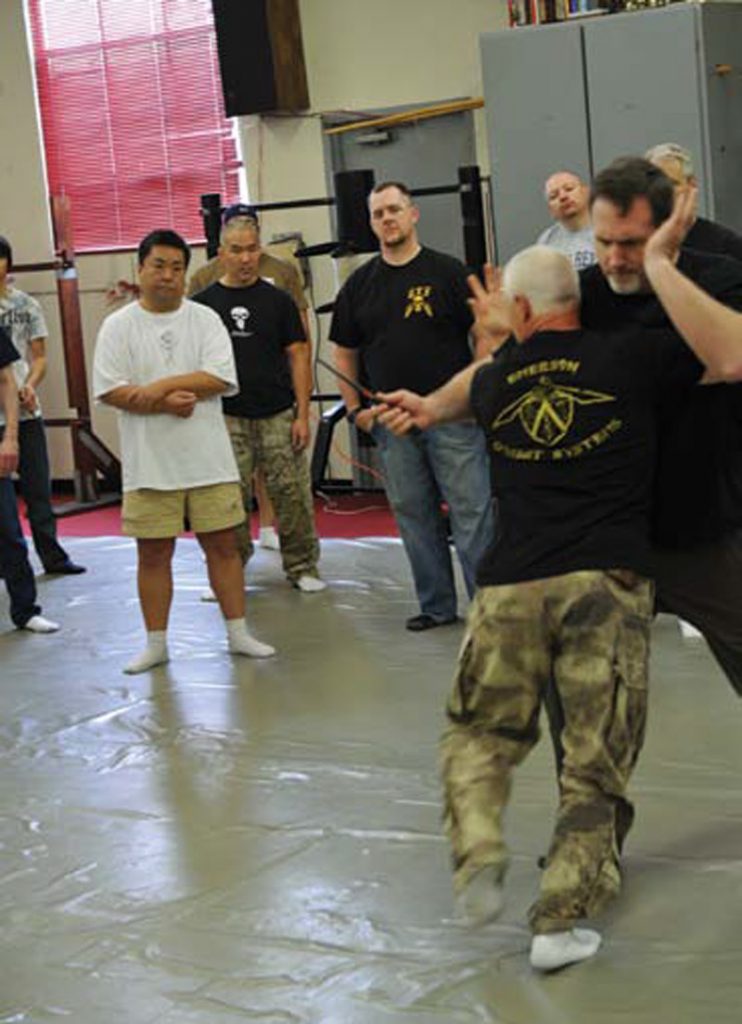
GUEST SPEAKERS
Emerson’s second Guest Speaker was world-renowned martial arts master, Sifu Richard Bustillo. Bustillo was one of the original students of Bruce Lee and is the founder and chief instructor of the International Martial Arts and Boxing Academy in Torrance, California. Bustillo demonstrated Jeet Kune Do principles for the class and expounded upon Lee’s direct concept of the “intercepting fist” and how to “absorb what is useful.” Bustillo has 30 years of experience with the Los Angeles County Sheriff’s Department and, in addition to teaching these important martial concepts, he addressed liability, escalation of conflict and use of force.
After Sifu Bustillo spoke, the class moved into more advanced sparring.
After sparring, we were introduced to the third guest speaker, Mike, a Navy SEAL who had seen action in Iraq. Mike talked to the class from his own experiences about reacting while under fire. He shared three stories illustrating the relationship between skill sets/body mechanics and mindset/ heart of a warrior.
- A BUD/S trainee was not physically up to the challenge but tried until he shattered his ribs and bloodied his face. He had the drive and the mindset but lacked the physical ability.
- A Forward Air Controller had gone through very specialized training and was hit by an Iraqi sniper. It was a through-and-through wound and hit nothing vital, but the FAC refused to fight. He had the skills and abilities of the SEALs, but lost his fighting mindset and will to fight.
- A SEAL was shot 14 times during a dynamic entry, passed out in a house full of insurgents and regained consciousness while they were reloading. He knew that when his teammates realized he was still inside, they would attempt a rescue. He drew his pistol and engaged the enemy, killing all of them and walking out of the house to the medevac.
In two of the stories, the protagonists had one but lacked the other. In the third story, the protagonist had both.
Class resumed after Mike’s talk, and the energy levels among the participants seemed to surge higher than before. Mike was definitely a motivating speaker and a good instructor in his own right. His lecture immediately helped me reassess what I was thinking with regard to my earlier injury.
In the final sparring session before graduation, I was struck in that same spot again! Ignoring the pain and thinking about the SEAL in story number three encouraged me to fight even harder.
During the awards ceremony, as Emerson gave out the completion certificates, he also held a lottery. Every student went home with a prize: custom knife clips, 1911 grips made in-house by Emerson, shot glasses, and in my case a Paladin Press book, of which Emerson had authored two chapters. A few students even went home with brand-new Emerson production knives.
ORDER OF THE BLACK SHAMROCK
Emerson introduced a new organization he has put together, known as the Order of the Black Shamrock. The Order’s rules are based on the laws of chivalry that governed medieval knights. All members pledge to live their lives by the rules of the Order. Additionally, Emerson announced two higher levels of membership: “Master-At-Arms,” awarded to members who demonstrate proficiency in two styles of combat; and “Knight,” which is the highest level. Bearers of that title must be nominated by other members of the Order. The first two Knights of the Order, Richard Bustillo and Sean Coulter, were inducted in a ceremony using an actual medieval knight’s sword and were presented with handmade Emerson Daggers and rights to title.

STUDENT COMMENTS
Emerson’s courses are primarily designed for police and military personnel who can walk out the door and put the material to use immediately. But anyone, regardless of skill level, can attend this course and take away something that will help them in a fight. The principles taught in the class are sound because they’re based on reality. This is an intense hands-on training regimen. People in our class broke fingers, were hit in the privates, and a few passed out from exhaustion.
After class, I spoke with some of my fellow students to gain their perspectives. One was a U.S. Border Patrol Agent named Smalls. He related that “I have minor martial-arts experience from my on-the-job training. I was able to take Mr. Emerson’s ideas and tactics to heart because I can apply 100% of them in my daily living, both on and off duty. Having the combat mindset and applying whatever tools you have at the time are what makes you successful. I have gone to countless training classes in my job, but this one was by far the most valuable training I have attended in a long time.”
Another student, a former Sailor named Rob, felt that “The class was as much about the mental aspect of personal defense as the physical, and is the reason why Emerson Combat is one of the top choices for learning how to deal with real-world violent scenarios. I took from the experience renewed self-confidence that, in a given situation, I have the basic tools to ensure my survival or that of my family. The staff is friendly, but dead serious when it comes to pushing you and challenging your mind and body to react in ways they’re not accustomed to. It’s not a singular solution to personal safety, but a tool that steadies your personal resolve to push forward and overcome your attacker.”
From my own point of view, while I didn’t learn any flashy new technique or “how to disarm a terrorist in five easy steps,” I did put everything I’ve learned about fighting and mindset over the past 30 years into place and was able to see it from a new vantage point. Emerson’s Extreme Close Quarters Combat Course is not a boxing camp or jujitsu camp that requires students to unlearn everything and start anew, but rather a legitimate lesson on real fighting.
